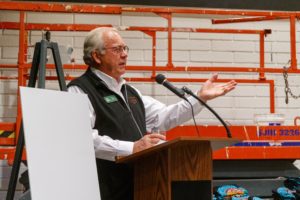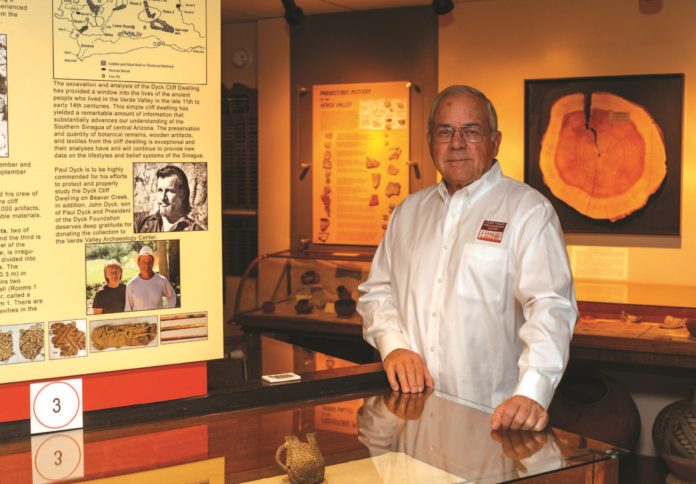The Verde Valley Archaeology Center’s Executive Director Ken Zoll is a busy man; although he does plan on slowing down, a little.
Zoll plans to retire from VVAC in September after spending the past 10 years working with the non-profit organization. However, he said “I’m not the type that’s going to sit there and stare at my trees in my backyard.”
While he does plan to spend more time with his wife, Nancy, Zoll also has plans to write two books, in addition to continuing his position as instructor with Northern Arizona University’s Road Scholar Program, which focuses on natural and cultural landscapes in red rock country.
Zoll also received a request from the University of Illinois to be a reviewer for articles for the Midcontinental Journal of Archaeology for which he said, he already has an article to review.
“So, things will pop up as the word spreads that I’ve retired,” he said. “Not that I’m looking, necessarily, but if something comes along that’s interesting …,” he trailed off, perhaps thinking about one of his “irons in the fire.”
Speaking of iron, one of the types of minerals found in meteorites, as a specialist in archaeoastronomy, or the astronomy of ancient cultures, one of the books Zoll plans to write will be about the “father of American meteoritics,” Harvey Harlow Nininger.
“Most of the meteorites that VVAC has on loan from Arizona State University were in the Nininger collection,” Zoll said.
A self-taught meteroricist, Nininger is known for reviving interest in the study of meteorites in the 1930s, and accumulated the largest collection of meteorites in the world, at that time.
Zoll said that Nininger worked for the Denver Museum of Natural History before forming his own meteorite museum on the outskirts of Meteor Crater.
“[Nininger] is credited with 146 discoveries of things related to meteorites; like how some meteorites have diamonds in them,” Zoll said. “Nobody knew that until he wrote his paper.”
Zoll said when Route 66 was bypassed by Interstate 40, the museum “kind of went downhill,” and when SR 89A was developed, Nininger moved his museum to Sedona, where it was in operation until about 1960.
Zoll described an encounter he had with a professor from Argentina who was seeking Nininger’s museum:
“She couldn’t find it; she went to the [Sedona] Visitor’s Center, they didn’t know what she was talking about, and I thought that was wrong, because [Nininger] was world-famous,” Zoll said. “The building is still there; it’s part of a motel. His house in Sedona is on the National Historic Register site. They even named the road — it’s on ‘Meteor Road,’ but nobody knows about him, so I thought, I’ve got to correct that.”
Perhaps Zoll saw a kindred spirit in Nininger, as Zoll’s own path to discovery bears a certain resemblance.
Prior his career as an “avocational archaeologist,” Zoll worked for the federal government as a technology and information officer for 35 years.
From Chicago, “I moved to Camp Verde in 2004; I got involved with archaeology in 2005, and then discovered the solar calendar at V Bar V [Heritage Site],” he said. “I started the study there in ’05 and finished in ’06.”
Over the years, Zoll continued with his pursuits in the field of archaeoastrology, cataloging 12 additional solar calendar sites in the Verde Valley, and authoring three books on the subject, including: “Understanding the Rock Art of Sedona, Heart of the Sky: Ancient Skywatchers of Central Arizona,” and “Sinagua Sunwatchers: An Archaeoastronomy Survey of the V Bar V Heritage Site and the Sacred Mountain Basin.”
Once he retires, Zoll plans to write another book about V Bar V, detailing the ranch’s history.
“When I became a docent in 2005 for the [U.S.] Forest Service, that’s where I spent most of my time; I was there continually for three plus years, and occasionally after that,” he said. “I got really interested in the ranch and its history. I was part of the excavation that was there; I was part of the historic survey that was there and did a lot of independent research on the site. It’s always been a goal, with the Forest Service’s approval, to write the history of the ranch.”
“There’s a lot of colorful history there that many people aren’t aware of, [such as] who owned it; it’s a very important site to the Hopi and the Yavapai-Apache, both of which [have been] kind of overlooked,” he added.
Zoll said he has been researching the ranch for a number of years and has “stacks of stuff” that he has recently begun organizing into a book.
“Hopefully I’ll have that by the fall,” he said.

KEN ZOLL, executive director of the Verde Valley Archaeology Center, speaks at the founders opening ceremony at the new Verde Valley Archaeology Center and Museum on Saturday, Nov. 20, in Camp Verde. The 11,000-square-foot facility in the Bashas’ shopping center opened to the public Nov. 26. Zoll and his wife Nancy were astonished by the reveal of a plaque, placed at the front of the building, dedicating the location to the Zolls. Zoll said VVAC was originally started in 2010 because there wasn’t anywhere to view, let alone study, American Indian artifacts in the Verde Valley. Archaeologists like Zoll identify the Verde Valley’s first human inhabitants as the nomadic Clovis Paleoamerican culture some 10,000 years ago, followed by the more sedentar y Hohokam, then the Sinagua, who built what is now called Tuzigoot and Montezuma Castle as well as hundreds of pit houses and cliff dwellings, before departing for unknown reasons around A.D. 1450. The Apache and Yavapai were the latest inhabitants when European explorers and American settlers arrived. Daulton Venglar/Larson Newspaper
VVAC Career Highlights
Zoll joked that when he began his career with VVAC, it was “one of those things where you show a little bit of interest then they ask, “How would you like to be president?”
Despite his humility, Zoll exudes a certain confidence about the purpose of his work and what it means to future generations with regard to the history of the Verde Valley.
For example, Zoll said VVAC “created the [Yavapai-Apache] exhibit, for the first time; a lot of people had never heard of the tribe until they saw our exhibit.”
In addition, other exhibits at VVAC include the Paul Dyck Cliff Dwelling Collection, ancient minerals and ores, ceramics and tradeware, and murals painted by Hopi artists Duane Koyawena and Filmer Keyanyama.
VVAC also owns land on Homestead Parkway in Camp Verde, where multiple ancient pit houses were discovered by a developer around 2014. The land was donated to VVAC after they’d spent a significant amount of time excavating the site.
One of Zoll’s most memorable experiences with VVAC includes the grand opening of VVAC’s original location, behind Thanks A Latte in 2011.
“Our membership was growing, but when we announced we were having our grand opening in this space, about 350 people showed up,” he said. “The town council was there to do their traditional ribbon-cutting. The mayor at the time, and some of the council people came up to me and said ‘What the heck is going on here? We’ve never had more than 20 people show up for a business opening.’ So, that was significant.”
Zoll said that because of the attention received by the council, when a larger space eventually opened up on Main Street, “they asked us if we could go from 650 square feet to 3,300 square feet, and we jumped at the chance.”
A few years later, “In 2014, VVAC received a grant to bring in Arizona State Museum curators to look at what we were doing,” he said. “We were expecting a list of things we could do to improve, and to our surprise they said we were highly qualified for the storage of collections from federal, state and private collections, which kind of blew us away.”
When the Paul Dyck Foundation received the news, they “walked in the door unannounced, and said, ‘we’ve decided to give you the entire collection of 50,000-plus items,’” Zoll said. “That was the final straw that led us to move and find a bigger space.
VVAC’s current location on Finnie Flat Road was acquired through “a combination of donations and land trades,” including a portion of the Homestead Parkway land, which does not include any of the excavated sites.
“One interesting thing that happened, when we moved to this location, being near Walgreens and Bashas’, Camp Verde membership has shot up dramatically,” Zoll said. “When we were on Main Street, they didn’t go on Main Street, they didn’t know we were there; now that they see us all the time, a lot of them have come in, with their out-of-town guests, but also to join, so that has been nice.”
Future of VVAC
While Zoll has expressed confidence in the abilities of his “most likely” replacement, VVAC’s current Deputy Director Monica Buckle, he said he hopes that the organization continues to receive the necessary donations and memberships to keep it going for the years to come.
“The board will most likely select her,” Zoll said. “She is a great asset; she is part Cherokee, and so she has a much better, closer rapport with the Native American community than any of us could have. She’s already opened up a few doors that I couldn’t.”
Zoll added that Buckle should be “just fine,” citing her younger age and higher energy levels as well as her Master’s Degree in Art Business from Sotheby’s New York.
However, “The greatest challenge, for any non-profit, is fundraising,” Zoll said. “There’s very little revenue generating from this [type of] business. Admissions probably account for 5% of our revenue; donations account for 60%.”
So far, VVAC has generated revenue from naming rights for the new building’s rooms, of which he said there are a “few opportunities” remaining.
“But, we’re going to be relying more and more on donations as we keep going, so we’ll do some classes, some lectures and special events,” which Zoll said he hopes will generate new memberships and donations.
“Part of the reason I’m moving on is because there is a lot of stress in fundraising,” he laughed. “It’s time for some of the younger folks to take over the stress of fundraising.”



